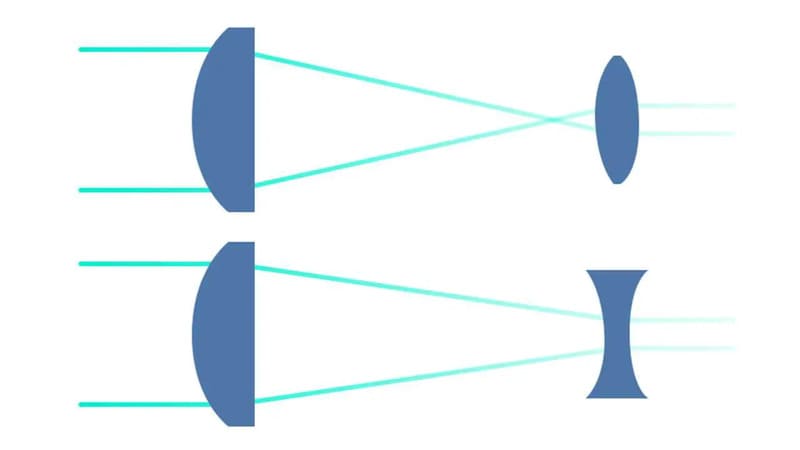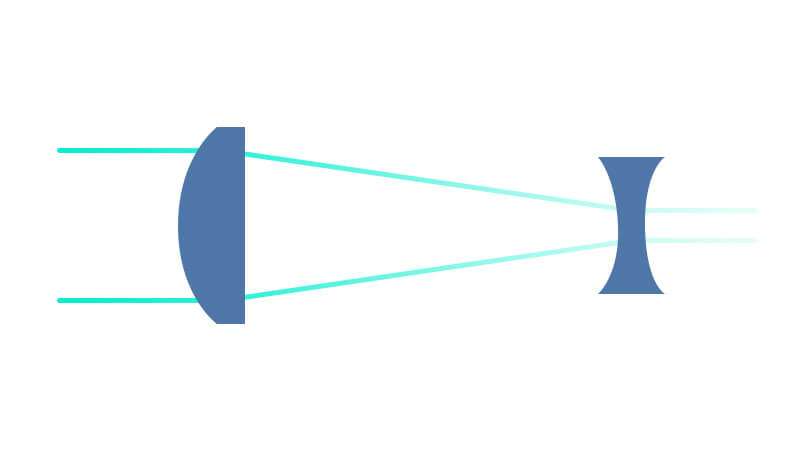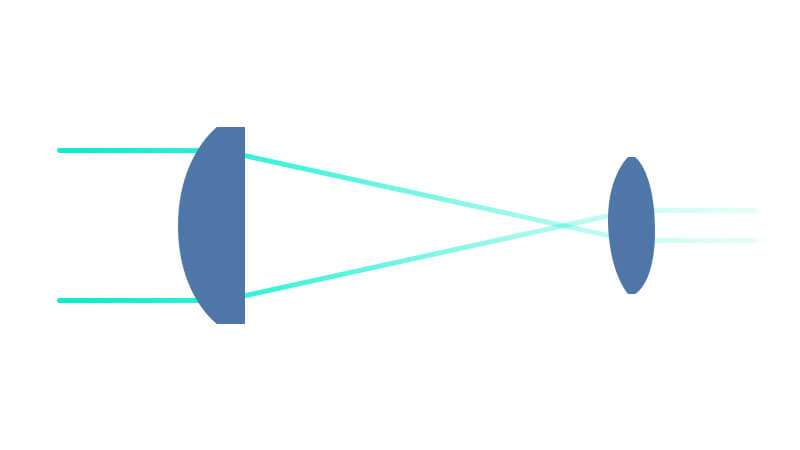Suppose you are new to the world of telescopes and the various types available. In that case, you may be interested in learning some of the basics. There are two main types of optical telescopes. Reflectors and refractors. But did you know for refractor telescopes there are two different designs?
The two refractor designs are Keplerian and Galilean. Each design serves a particular purpose, each with its advantages and disadvantages. You’ll need to ensure you select the right design for your needs. This article will compare and contrast the Keplerian vs Galilean Telescope.
In this article, you get
A comparison of the Keplerian telescope vs Galilean design
A deep-dive into the difference between Galilean and Keplerian telescope
A foundational understanding of refracting telescopes
A closer look at optical aberrations you should be aware of
By the end of this article, you’ll understand the critical difference between Keplerian and Galilean telescope designs, which one to choose based on your needs, and much more!
Let’s dive right in.
Recommended For You
KEPLERIAN VS GALILEAN TELESCOPE: THE MAIN DIFFERENCE

There are many differences between the Kepler vs Galileo telescope.
The essential difference is that the Keplerian telescope is better suited for observing distant objects in outer space, such as stars and planets.
On the other hand, the Galilean telescope is mainly a terrestrial telescope. It also detects far objects (on land) and can be used to observe not-so-distant celestial objects, such as the Moon.
But, can you use a telescope to see the flag on the moon?
Because of this main difference, the Keplerian telescope is considered an astronomical telescope.
The underlying reason for this difference is the lenses used in each type of telescope.
The Galilean telescope uses one convex lens and one concave lens.
The Keplerian telescope uses two convex lenses. This design has some significant advantages and disadvantages, which I’ll explain later in this article.
Let me start with the Galilean design, as this one came first. I’ll then compare and contrast it to the Keplerian design, which came along a few years later.
REFLECTING TELESCOPES
If you’d like to have a refresher on reflecting telescopes, invented by Isaac Newton, read my articles What is a Newtonian Telescope? and Refractor Telescope vs Reflector.
WHAT IS A GALILEAN TELESCOPE?

Galileo Galilei didn’t invent the telescope. That distinction goes to Hans Lippershey, the first to file for a patent in 1608.
Soon after, Galileo Galilei used that design to build his own, point it skyward, and observe celestial objects. In 1610 he published a book of his findings, which made him famous.
Because of Galileo’s practical use of this first telescope, the design is called a Galilean telescope (as opposed to a Lippershey telescope).
The Galilean telescope significantly increased our ability to see across long distances. The design is still used today and assists with many tasks related to shipping, land exploration, and even military operations.
Although the telescope first used by Galileo was rather rudimentary compared to today’s Galilean telescopes, the basic design is still the same.
How does Galileo’s telescope work?
GALILEAN TELESCOPE DESIGN
The Galilean telescope diagram uses one convex lens and one concave lens.
The convex lens at the front is the objective lens because it’s closest to the object. The concave lens at the rear is used as the eyepiece and is the ocular lens.
These two lenses work harmoniously to allow x magnification of objects in the distance versus the naked eye. When you zoom in on something, you see a narrow field. The more amplified or multiplied the object in the telescope, the smaller the field of view.
When assembling a Galilean telescope, the convex objective lens faces toward the vision field. The arrangement of the different lenses serves to magnify images best for terrestrial use because the final image remains upright. In other words, the Galilean telescope image is not inverted, as we’ll see later in the Keplerian design.
The convex lens refracts the parallel light rays from the distant object. The diverging lens of the eyepiece (concave lens) makes the light beams parallel again. This is clear in the above Galilean telescope ray diagram.
Thanks to this design not having an intermediary focus, it creates erect images.
Initially, people used the Galilean telescope for both astronomical and terrestrial purposes. With the development of the Keplerian telescope, the Galilean telescope has found its primary purpose in being a terrestrial telescope. The tube length is also a primary factor in magnifying the image further.
Galilean telescopes are still highly relevant and useful for various industries and hobbyists today.
Galilean telescopes don’t have the magnifying power and precision of the Keplerian telescope. However, they are still a sound investment for multiple purposes with a design that’s been relatively unchanged since their creation hundreds of years ago.
WHAT IS A KEPLERIAN TELESCOPE?

In 1611, Johannes Kepler improved upon Galileo’s design (or, shall we agree, Lippershey’s design).
KEPLERIAN TELESCOPE DESIGN
The significant improvement Kepler made was to use two convex lenses, both for the objective lens (front) and the ocular lens (convex eyepiece lens).
Both of these lenses converge the light, increasing the magnification power compared to the Galilean telescope.
The Keplerian version of the telescope is ideal for astronomical observations of distant objects in outer space, such as stars, planets, and other celestial objects.
Because the x magnification of the Keplerian telescope is much higher than that of the Galilean telescope, it accounts for most of the telescopes amateur astronomers use today.
Like the Galilean telescope, the converging objective lens (first lens) acts as a high-powered magnifying glass that helps you see distant objects in space, like the Milky Way. The objective lens of the telescope catches the light and refracts it.
The converging lens eyepiece increases the amount of light you can see.
The telescope’s purpose is to gather the light of distant objects in the night sky and create a virtual image. It’s important to note that you, or your camera, form the image rather than the telescope itself. The angles at these two lenses concentrate the light and determine the telescope’s angular magnification.
One of the drawbacks of the Keplerian telescope is that it generates an inverted image. The refracted light crosses itself between the first and second lens, resulting in an inverted image.
To flip the image, if needed, you can insert an erector lens between the eyepiece and the objective lens. To learn more about this, read my article Why is my telescope upside down?
CHOOSING A TELESCOPE
Choosing the right telescope for your needs is relatively simple once you’ve understood the concept of both the Keplerian telescope and the Galilean telescope.
If you’re mainly interested in terrestrial observation, which requires an upright image, a Galilean telescope will meet your needs. These are great when navigating open water and viewing distant objects across expansive spaces, like from the top of a mountain or across a large open field.
This type of refracting telescope is also an excellent option for beginner astronomy enthusiasts who want to begin the exploration of closer objects in space. The Galilean telescope is much simpler to build, and many people find it enjoyable to create their own.
In contrast, the Keplerian telescope would be ideal for most amateur astronomers. Keplerian telescopes provide access to higher magnification, a sharper image, and a small field of view of distant objects in the Milky Way and beyond.
If you’re interested in viewing planets, read my article Can You See Planets With A Telescope? and for some fun, read my articles
- Can you see the ISS with a telescope?
- Can you use a telescope to see the flag on the Moon?
- DIY Solar Filter Telescope
CHROMATIC ABERRATION
Both the Keplerian and Galilean refracting telescopes will suffer from chromatic aberration.
Chromatic aberration creates strange color effects on the edges of the final image due to different wavelengths of light refracting at different angles through lenses.
SPHERICAL ABERRATION
Another aberration to be aware of in refracting telescopes is spherical aberration.
Spherical aberration creates a slightly out-of-focus image because the light refracted at the edges of the lens is different from that at the center of the lens. The refracted light meets at a different point, which causes a slightly blurry image.
FREQUENTLY ASKED QUESTIONS
HOW WERE GALILEO AND KEPLER DIFFERENT?
Galileo Galilei and Johannes Kepler were two of the most important astronomers of the early modern era. Galileo was an Italian physicist and astronomer who made groundbreaking observations of the planets and stars with his telescope. Kepler was a German mathematician and astronomer who developed the laws of planetary motion. While both Galileo and Kepler made essential contributions to astronomy, they had different approaches to their work. Galileo was more interested in making empirical observations, while Kepler was more interested in developing theoretical models. Galileo is best known for his observations of the planets and stars. In contrast, Kepler is best known for his laws of planetary motion.
WHICH TELESCOPE IS BEST FOR VIEWING THE MILKY WAY?
The best type of telescope for viewing the Milky Way is the reflector. Refractor telescopes are well-suited for viewing objects that are bright and close to the Earth, such as the Moon or planets. On the other hand, Reflectors are best for viewing faint deep-sky objects and ideal for observing the Milky Way and other galaxies.
Summary: Galilean vs Keplerian telescope
Thanks for reading my article comparing the Galilean telescope vs Keplerian.
Keplerian and Galilean telescopes are two different astronomical instruments with unique characteristics.
The Galilean vs Keplerian telescope debate should now be over. Each one serves a unique purpose.
The Keplerian telescope is ideal for studying distant objects in the Universe. In contrast, the Galilean telescope is a shorter-range instrument that you can also use for terrestrial observation.
The Kepler telescope design offers a higher magnification than the Galilean but with less light-gathering power. Its longer focal length creates an image that is upside down, unlike the images created by a Galilean, which are right side up. For information on focal ratio, read my article What is Focal Ratio on a Telescope?
You can now decide whether to use a Keplerian or a Galilean telescope for your astronomical observations. And if you have both, you should now know why there’s a difference between your Galilean and Keplerian telescope.




